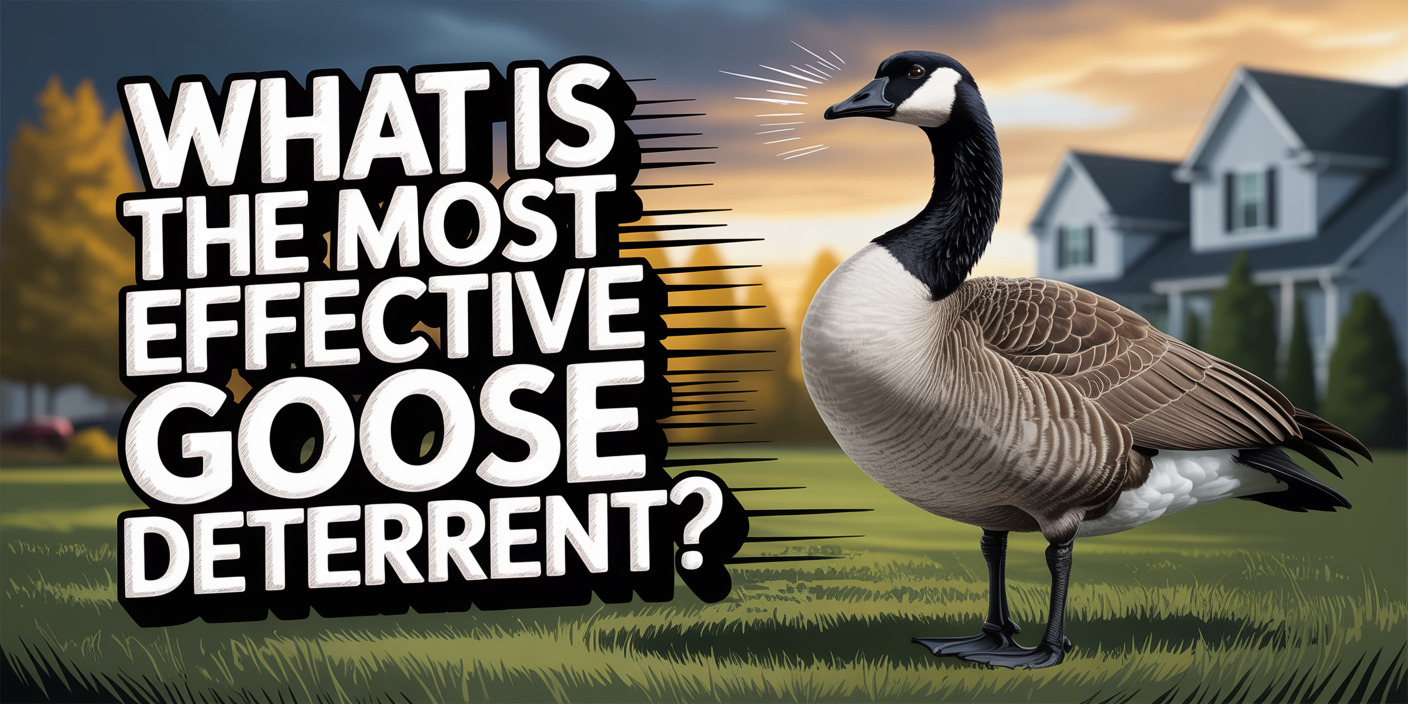The most effective goose deterrents combine visual scare tactics, habitat changes, and ongoing maintenance.
Geese might look harmless at first—but once they’ve settled in, they’re loud, messy, and downright territorial. In Phoenix, where man-made lakes, golf courses, and grassy parks dot the landscape, these birds often overstay their welcome. Their droppings damage lawns, their honking disturbs the peace, and their nesting behavior can get aggressive fast.
Finding the most effective goose deterrent in Phoenix isn’t just about chasing birds away. It’s about using the right tools, at the right time, in a way that’s legal and humane. Whether you manage a community lake or just want your backyard back, this guide will walk you through what actually works to keep geese from turning your property into their permanent hangout.
What Problems Do Geese Cause in Phoenix?
While Phoenix isn’t exactly known for wetlands, Canada geese have adapted well to man-made landscapes. They flock to golf courses, retention ponds, HOA lakes, and business parks—leaving behind a trail of droppings that stain walkways, kill grass, and make outdoor spaces nearly unusable. These droppings can also pose a health risk, carrying bacteria like E. coli into nearby water sources and play areas.
During nesting season, geese can become aggressive toward anyone who gets too close. Property owners often deal with protective parents chasing people, blocking paths, or even attacking pets. Add in the cost of cleanup, lawn damage, and reputation issues for commercial spaces, and it’s clear that geese aren’t just a noisy annoyance—they’re a costly one, too.
Why Are Geese Attracted to My Property?
Geese are drawn to properties that offer easy access to food, water, and safety—and in Phoenix, that usually means lush lawns, decorative ponds, and wide-open spaces with minimal disturbance. Even small lakes or irrigation retention basins can look like the perfect landing spot to a passing flock. Once they arrive, the combination of short grass for grazing and calm water for resting makes them feel right at home.
Unlike other birds, geese are creatures of habit. If your property provides what they need during one migration, there’s a good chance they’ll come back every season. Even worse, they may decide to stay year-round if the climate is mild and there’s no consistent deterrent in place. That’s why prevention is just as important as removal—it keeps your space from becoming part of their regular routine.
What Is the Most Effective Goose Deterrent?
Geese are persistent, but with the right combination of methods, you can make your property uninviting without causing harm. Here’s a breakdown of the most effective deterrents that actually work in Phoenix’s climate.
Goose Fencing and Netting
Temporary fencing around shorelines, ponds, or grassy areas can block geese from walking up onto land after they’ve landed in the water. This method interrupts their travel path and encourages them to find a more accessible spot elsewhere. Low-profile fencing about 18 to 24 inches high is often enough to do the trick, especially when used in early spring before nesting starts.
For areas like courtyards or rooftops where geese may roost, bird netting can be installed to physically block them from landing or nesting. It’s not always necessary for residential yards, but for commercial and industrial properties with repeat goose activity, netting offers a durable, long-term solution.
Visual Deterrents (Decoys, Reflective Tape, Predator Kites)
Geese are alert to movement and predators, so visual deterrents like coyote decoys, reflective tape, or even predator-shaped kites can work well when used consistently. These tools play on the bird’s natural fear instincts, especially when placed near nesting zones or feeding areas. They’re most effective when repositioned frequently to prevent the geese from getting used to them.
In Phoenix, lightweight kites that resemble hawks or eagles are especially effective when the wind picks up. Reflective streamers or balloons near water features or lawns also disrupt their comfort zone by creating unpredictable movement and light flashes. While not a standalone solution, they’re a great part of a multi-layered deterrent system.
Audio Deterrents (Distress Calls, Sonic Blasters)
Geese are highly vocal and responsive to sound, which makes audio deterrents a great way to unsettle them. Devices that emit distress calls or predator sounds can signal danger and discourage birds from landing or nesting. This works best in open areas like parks, business complexes, or fields where sound can carry.
For Phoenix properties near highways or commercial zones, audio deterrents can blend into the noise landscape without bothering neighbors. Be sure to rotate the sounds and use them at key times—like early morning or dusk—when geese are most active. Just avoid using them too late at night to stay in good standing with the community.
Laser Systems
At dawn or dusk, laser deterrents can be surprisingly effective. These systems sweep laser beams across open areas, which geese perceive as a physical threat. Because the lights don’t make noise and don’t harm the birds, they’re perfect for suburban neighborhoods or golf courses that need a low-impact solution.
Lasers work best in low-light conditions, so while they might not be useful during the day, they shine—literally—as part of an evening goose control plan. Just be sure to follow safety protocols so the beams don’t interfere with drivers, pets, or people nearby.
Habitat Modification
Geese love short grass and easy walkways to water. Changing that environment is one of the most reliable ways to make your property less inviting. Planting tall grasses or native shrubs near shorelines limits sight lines and makes landing feel risky. Sloped banks instead of flat edges also prevent easy water access.
In Phoenix, where drought-resistant landscaping is popular, replacing grass with gravel, native plants, or mulch doesn’t just save water—it deters geese, too. Modifying the landscape to remove their favorite comfort spots can dramatically reduce their interest in staying.
Trained Goose-Repelling Dogs
Specially trained herding dogs like border collies are one of the most effective natural deterrents available. These dogs don’t hurt the birds—they just use presence and body language to make the area feel unsafe. The geese interpret this as a predator in residence and tend to leave quickly.
Professional goose control teams often use trained dogs for large or heavily affected properties like parks or school grounds. Regular patrols, especially during nesting season, can condition geese to avoid the area entirely. It’s humane, reliable, and surprisingly fast when done right.
Goose Repellent Sprays
Non-toxic chemical sprays can be applied to lawns and turf to make the grass taste and smell unpleasant to geese. These are safe for humans and pets but cause mild digestive discomfort or irritation in birds, encouraging them to move on. Many products use grape seed extract or methyl anthranilate as the active ingredient.
These sprays are a great backup for places where fencing isn’t possible or where frequent grazing has become a problem. In Phoenix’s hot sun, reapplication may be needed more often due to evaporation, so consistency is key for long-term success.
What Methods Don’t Work Long-Term?
Some goose deterrents might look promising at first but lose their effectiveness quickly. Take fake owls or stationary decoys, for example. Geese are smart and highly adaptable, and once they realize these “predators” don’t move or pose a real threat, they’ll go right back to business as usual. This is why relying solely on visual props that don’t rotate or relocate just won’t cut it.
Occasional noise like clapping, shouting, or using air horns may startle geese once or twice, but they’ll quickly tune it out without consistent reinforcement. Feeding bans are another common approach that often falls flat because they’re hard to enforce and don’t address the real reasons geese are hanging around. For long-term success, deterrents need to stay fresh, dynamic, and used in combination—not just as one-off fixes.
Are Goose Deterrents Legal in Phoenix, AZ?
Yes—goose deterrents are legal in Phoenix, but there are important rules to follow. Canada geese are protected under the Migratory Bird Treaty Act, which means it’s illegal to harm, trap, relocate, or destroy their eggs or nests without a special federal permit. That’s why deterrents must be humane, non-lethal, and focused on discouraging geese from settling rather than physically removing them.
Homeowners, HOAs, and businesses in Phoenix can legally use visual, audio, and habitat-based deterrents as long as they don’t harm the birds. For more aggressive methods like egg addling or professional hazing, it’s best to work with a licensed wildlife control company that understands both the legal restrictions and the best seasonal timing. Always check with your local municipality or a wildlife expert before taking matters into your own hands.
Contact AAAC Wildlife Removal of Phoenix
If geese are taking over your lawn, damaging your property, or making your business look like a bird sanctuary, it’s time to call in the pros. AAAC Wildlife Removal of Phoenix specializes in humane goose deterrent solutions that actually work—no guesswork, no legal headaches, just proven results. Whether you’re dealing with a few stubborn visitors or a full-blown nesting problem, our team knows exactly how to handle it.
We serve homes, golf courses, HOAs, and commercial properties across Phoenix, Scottsdale, Mesa, Tempe, Glendale, and nearby areas. With local knowledge and fast response times, we’ll help you reclaim your space and keep it bird-free for the long haul. Call now or use our quick contact form to schedule an inspection. Your property deserves peace and quiet—and we’re here to make sure you get it.
Conclusion
Geese may be federally protected, but that doesn’t mean you have to tolerate the mess, noise, and damage they bring. The most effective goose deterrent isn’t a one-size-fits-all trick—it’s a thoughtful mix of visual cues, habitat changes, and expert timing. When applied consistently, these tools can make your Phoenix property a no-fly zone for unwanted flocks.
If DIY efforts haven’t cut it or the geese keep coming back, don’t wait for the next round of nesting season to hit. AAAC Wildlife Removal of Phoenix is ready to help with fast, humane, and fully legal solutions tailored to your property’s needs. Let’s send those geese packing—for good.




